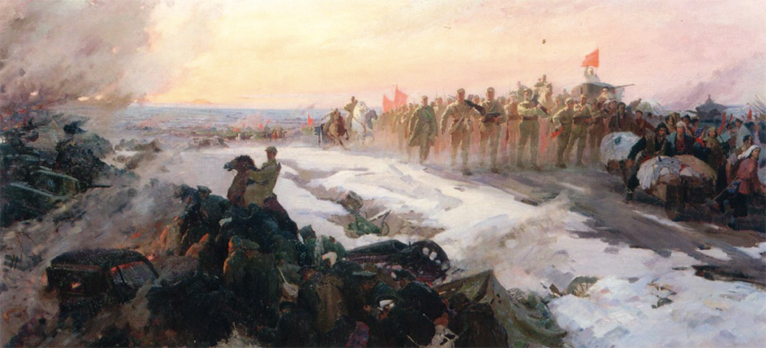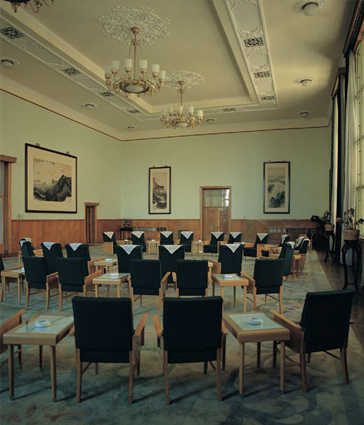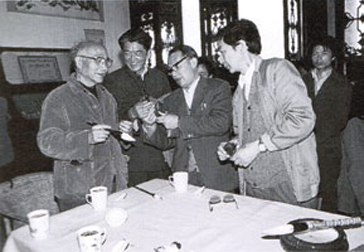FIFTY YEARS ON: A LIFE IN THE ANHUI ARTISTS ASSOCIATION
| June 20, 2011 | Post In LEAP 9

THE WINTER OF 1960 was freezing cold. It was a time when the Republic was solemnly suffering famine and hardship. In Anhui, the art world had just come out of the struggle against Anti-Revisionism and the Anti-Rightist Movement, and everybody was feeling unusually depressed. Our only thread of hope came from the Provincial Party Committee, in the form of plans to establish several professional associations. In July of that year, after the China Artists Association had held its second national assembly, the Anhui Provincial Department of Culture hatched a plan to establish an Anhui branch of the China Artists Association. The Deputy Secretary of the Anhui Provincial Propaganda Department, Lai Shaoqi, was slated to be the head planner and leader of the branch, and as chairman of the Provincial Department of Culture, not only did he lead planning for the Anhui Artists Association, but he also had to spearhead preparations for the Writers Association, the Dramatists Association, and the Musicians Association. As recounted in the minutes taken at what was then the Hefei Theater, it was during the last ten days of December 1960 that Secretary-General of the China Artists Association Hua Junwu officially sent his congratulations to the first assembly of the Anhui chapter.
The First Chairman of the Anhui Artists Association was Lai Shaoqi. I was Deputy Secretary General of the standing committee. The association was housed on the first floor of what is today the Citizen’s Art Gallery, but later moved to the Sino-Soviet Friendship Center on Suzhou Road. Old Lai paid extra special attention to the work of the Association. In accordance with his instructions, we would respectfully call upon venerable old painters, hold symposia in search of advice and opinions towards fomenting a more prosperous arts scene in Anhui; we even organized a “Yellow Mountain Nature Sketching Group” in conjunction with the Jiangsu Institute of Chinese Painting— lead by Song Yiying and Ya Ming (of Jiangsu province) and including the participation of artists Qian Songyan, Song Wenzhi, Wei Zixi, Wang Shicen, and others— that would go on to hold related group exhibitions in Hefei and Nanjing. The association also took its assignment to decorate the Anhui Room of the Great Hall of the People in Beijing as an opportunity to display unique arts and crafts of Anhui province, like the iron pictures of Wuhu, the brick carvings of Huizhou, the pottery of Jieshou, and so on. We had the old iron picture artist Chu Yanqing appear before the Association’s directors, and the Association even used its limited funding to send Professor Zhou Wu to visit museums and libraries all over the country in order to gather information on Ming and Qing Dynasty-era engravings of the Huizhou school. He gathered nearly 1,000 images, and attempted to duplicate them as rubbings on xuan paper. Finally, we invited famous professors such as Li Kuchan and Ni Yide to come to Hefei to give lectures and organize exhibitions.

In 1961, the Propaganda Department was informed by the Museum of the Chinese Revolution that I should go to Beijing to take part in creating the historical painting of the Revolution Huaihai Victory. Afterwards, I spent two years studying at the Central Academy of Fine Arts, which was a major turning point in my life. But by the time I had returned from these studies, the Provincial Cultural Department had been broken up, and the Artists Association was no more, either.
The year 1979, after the Cultural Revolution ended, is commonly referred to by the art world as “the Renaissance.” In April of that year, the Anhui Artists Association was reestablished, and although for unexpected reasons I had officially stopped working, I remained Secretary-General in name. In 1984 I once again took reigns of the Association and immediately commenced recruitment for the Sixth National Fine Arts Exhibition. I also worked with the Provincial Art Research Institute and the Anhui Provincial Museum towards planning “The Huangshan School Academic Symposium in Commemoration of the 320th Anniversary of the Great Masters of Zhejiang,” an important event in the peopled history of the Anhui arts world. Over 200 people participated, including painters, art historians, and Sinologists from America, France, England, Hong Kong, Taiwan, and the Mainland. Anhui Provincial Museum had borrowed over 200 works of Ming and Qing Dynasty-era painters of the Xin’an School from major museums across the country, as well as over 100 excellent major treatises and dissertations. The famous overseas art historians and Sinologists James Cahill and Li Chu-Tsing also appeared to give presentations.

In July, 1987, the China Artists Association sent me to France and Europe to conduct research for seven months. That year, the Anhui Artists Association organized a number of exchanges with Bulgaria, Japan, Singapore and other countries, with wonderful results. In 1980, one thing in particular attracted the attention of the art world across the country: the arrival of the great American Modernist Robert Rauschenberg. With him, the globally renowned artist brought ten professors and assistants to Jingxian in Anhui, where, using Chinese xuan rice paper, he created works of modern art. The Vice-Chairman of the Association Shi Songjing accompanied Rauschenberg to Jingxian, which was quite the delicate task: as xuan paper is considered a national secret, foreigners shouldn’t be allowed to enter the factory. It was reason enough to justify sending a master worker— politically reliable and familiar with the rice paper production process— to the Jingxian hotel with the pulp and tools necessary to make the paper for Rauschenberg there. There in Jingxian, Shi Songjing and Lin Zhiyue helped Rauschenberg create nearly fifty different artworks. A little more than one month later, wanting to recompense us for our assistance, the Americans asked Old Lai to help them calculate expenses. Which he did, in turn asking the Bureau of Foreign Trade to assist with the conversion, only to discover that the paper was only worth a few dozen renminbi. After returning to the States, though, Rauschenberg ended up selling those paintings to museums and galleries all over the world for tens of thousands American dollars [each]. In 1993, I saw some of these paintings in the United States, in the Metropolitan, in MoMA, and in the National Gallery. I remember that the trademark red border of the Jingxian xuan factory and the two seals left by Old Shi—fu, meaning “auspicious,” and shou, meaning “longevity”— stood out vividly. An American painter said to me: “You helped him make these, and he made use of materials from Anhui. With all the energy and resources you put into it, he should have paid you at least one thousand dollars [each]. How naïve you are!” I responded, “How were we supposed to know he was so famous, or that his paintings were worth so much money!”
In 1999, on the threshold of the new century, the time came for me to retire. But before, the Provincial Artists Association organized a conference, “Art Theory in the New Century,” for which I gave a speech. In it, I outlined my belief in the “New Huizhou School” tradition championed by Old Lai: the fundamental notion that artwork should represent the time when, and place where it was created.

